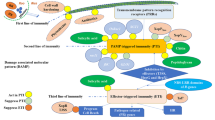Abstract
Selection on partial resistance components, namely latent period, development rate of uredia and number and size of uredia, has been suggested as a means to achieve durable resistance. Three experiments were carried out in growth chambers to assess the impact of environmental and genetic factors on these components in the Salix-Melampsora host-pathogen system. They confirmed the environmental ability of the Melampsora-Salicaceae relationship and provided no definite answer on the possibility of attaining durable resistance through selection on partial resistance components. On the one hand, there is a large amount of heritable variation among clones for most components; on the other hand, all components were extremely sensitive to environmental conditions and isolates, making the development of standard selection methods difficult.
Similar content being viewed by others
References
Briggs SP, Johal GS (1944) Genetic patterns of plant host-parasite interactions. Trends Genet 10:12–16
Bull JJ (1994) Virulence. Evolution 48:1423–1437
Caten CE (1987) The concept of race in plant pathology. In: Wolfe MS, Caten CE (eds.) Populations of plant pathogens: their dynamics and genetics. Blackwell, Oxford, pp. 21–37
Falconer DS (1981) Introduction to quantitative genetics, 2nd edn. Longman, London
Gullberg U (1993) Towards making willows pilot species for copping production. For Chron 69:5–10
Gullberg U, Ryttman H (1993) Genetics of field resistance to Melampsora in Salix viminalis. Eur J For Pathol 23:75–84
Heather WA, Chandrashekar M (1982) Evolutionary, epidemiological and ecological implications of forms of resistance in Populus ssp. to Melampsora leaf rust. Aust For Res 12:231–144
Houle D (1992) Comparing evolvability and variability of quantitative traits. Genetics 130:195–204
Julkunen-Tiitto R (1989) Phenolic constitution of Salix: a chemotaxonomic survey of further Finnish species. Phytochemistry 28:2115–2125
Kang H, Lascoux M, Gullberg U (1995) Systematic tree breeding. In: Mandal AK (ed) Tree breeding. Indian Council of Forestry and Education, New Delhi, (in press)
Kremer A, Lascoux DM (1988) Genetic architecture of height growth in Maritime pine (Pinus pinaster Ait.) Silvae Genet 37:1–8
Lefèvre F, Pichot C, Pinon J (1994) Intraand interspecific inheritance of some components of the resistance of leaf rust (Melampsora larici-populina Kleb.) in poplars. Theor Appl Genet 88:501–507
Leonard KJ (1987) The host population as a selective factor. In: Wolfe MS, Caten CE (eds) Populations of plant pathogens: their dynamics and genetics. Blackwell, Oxford, pp 163–179
May RM (1985) Host-parasite associations: their population biology and population genetics. In: Rollison D, Anderson RM (eds) Ecology and genetics of host-parasite interactions (Linnean Society Symposium Series). Academic Press. London, pp 243–262
May RM (1992) Resisting resistance. Nature 361:593–594
Nowak MA, May RM (1994) Superinfection and the evolution of parasite virulence. Proc R Soc London Ser B 255:81–89
Parlevliet JE (1993) What is durable resistance, a general outline. In: Jacob T, Parlevliet JE (eds) Durability of disease resistance. Kluwer Academic, The Hague, pp 23–39
Parlevliet JE, Van Ommeren A (1988) Accumulation of partial resistance in barley to barley leaf rust and powdery mildew through recurrent selection against susceptibility. Euphytica 37:261–274
Saarikoski P, von Arnold S, Clapham D, Gullberg U (1992) Genetic differences in wound-induced ethylene production among different clones of Salix viminalis L. Silvae Genet 42:121–126
Salisbury FB, Ross CW (1985) Plant physiology, 3rd edn. Wadsworth Publ, Belmont, Calif.
Sas Institute (1985) SAS/STAT guide for personnal computers, Version 6. SAS Institute, Cary, NC.
Suneson CA (1960) Genetic diversity — a protection against diseases and insects. Agron J 33:451–466
Suzuki K (1973) Studies on the suspectibility to popular leaf rust influenced by different nutrient conditions. I. Change of susceptibility induced by nutrient deficiency. J Jpn For Soc 55:29–34
Author information
Authors and Affiliations
Additional information
Communicated by P.M.A. Tigerstedt
Rights and permissions
About this article
Cite this article
Lascoux, M., Ramstedt, M., Åström, B. et al. Components of resistance of leaf rust (Melamspora laricii epitea Kleb./Melampsora ribesii-viminalis Kleb.) in Salix viminalis L.. Theoret. Appl. Genetics 93, 1310–1318 (1996). https://doi.org/10.1007/BF00223464
Received:
Accepted:
Issue Date:
DOI: https://doi.org/10.1007/BF00223464




